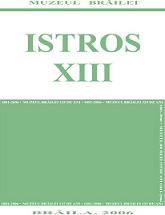Elitele geţilor dintre Carpaţi şi Balcani (sec. IV-III a. Chr): "Prinţii de aur şi argint"
Getae Elites between the Carpathians and Balkans (4th-3rd centuries BC): “Gold and Silver Princes”
Author(s): Valeriu SîrbuSubject(s): History
Published by: EDITURA ISTROS A MUZEULUI BRĂILEI „CAROL I”
Summary/Abstract: Chance or systematic archaeological findings between the Dniestr, Black Sea, Carpathians and the Balkans, have brought to light vestiges with similitudes that, when corroborated with written sources, can be attributed to the Getae. The “society of living”, which is to say the ruler and the community, tried to embody their prestige in the residential centers. As for the tombs, they were the result of the thoughts of the individual and the family on integrating oneself in the “community of the dead”. Finally, the practice of burying treasures points to their views on the “invisible partners” that were the deities, which were never absent from their worldviews. There is little doubt concerning the existence of a common ideology for the Getae aristocracy in the area in question, given the existence of a set of common items, images and figurative scenes. Moreover, the way these three types of findings show up on the map, namely in higher numbers in particular areas, suggests the presence of centers of power and authority in those areas. “Descoperirile arheologice dintre Balcani, Carpaţi, Marea Neagră şi Nistru evidenţiază, pe de o parte, o serie de vestigii cu trăsături comune care, coroborate cu sursele scrise, pot fi atribuite geţilor şi, pe de altă parte, diferenţe notabile între posibilităţile materiale ale comunităţilor şi indivizilor. Existenţa unor trăsături specifice doar geţilor, diferite de restul neamurilor tracice, menţionată de sursele scrise (Herodot IV, 93-94), este confirmată şi de un set de piese şi compoziţii decorative ce atestă o ideologie caracteristică doar acestora. În prezentul studiu ne vom referi la acele categorii de vestigii care evidenţiază o puternică structurare şi ierarhizare a societăţii getice, anume la: a) centrele rezidenţiale, care reflectă prestigiul dinastului şi al comunităţii, deci al „societăţii celor vii”, b) la morminte, care sunt reflecţia individuală/familială despre cum persoanele depuse acolo se vor integra în „comunitatea celor care dorm”, c) îngroparea de tezaure, care ne sugerează modul cum ei se raportau la divinităţi, adică la acei „parteneri invizibili”, dar omniprezenţi în mentalităţile lor, şi la strămoşii venerabili, care veghează la bunăstarea lor.”[…]
Journal: ISTROS
- Issue Year: 13/2006
- Issue No: 1
- Page Range: 41-70
- Page Count: 30
- Language: Romanian
- Content File-PDF

